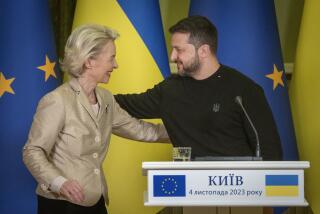Breakaway Soviet Republics All Invited to Join a New Economic Union : Reforms: They are asked to speed up development of a free-market system and pull the country out of its crisis.
- Share via
MOSCOW — The Soviet Union’s breakaway republics were asked on Wednesday to form a new economic union designed to accelerate the development of a free-market economy and pull the country out of its deepening crisis.
Grigory A. Yavlinsky, vice chairman of the transitional committee overseeing the Soviet economy, said all 15 of the country’s onetime constituent republics--all but four of which have declared their independence--were invited to join the new economic union, either as full members or associates, and to agree on its basic terms within a month.
If they do not, Yavlinsky said that the Russian Federation, the biggest and by far the richest republic, is ready to proceed with the reforms alone--and to retain most of the assets of the old Soviet Union.
“Russia can’t wait a long time,” Yavlinsky warned. “If the other republics don’t show a desire to start economic reforms and the stabilization program, Russia is ready to start them by itself.”
Yavlinsky, one of Russian President Boris N. Yeltsin’s economic advisers, then set a deadline of a month for agreement on the basic treaty. “Economic union is not a choice--it is rather a necessity,” he said.
Aimed at halting the Soviet Union’s disintegration as one of the world’s largest economies--and accepting its political collapse as a state--the treaty proposes the establishment of an economic union of independent states, including those that will have no further links to the other republics.
Modeled in part on the initial Common Market established in Western Europe in 1957, the proposed economic union is at the core of efforts by President Mikhail S. Gorbachev and Yeltsin to hold together as much of the Soviet Union as they can in a loose confederation of independent states.
Although leaders of 10 republics support the concept, controversy appears certain. The free-market reforms that are its philosophical base have been weakened in the interest of stability. The devolution demanded by the independence-minded republics is present politically, but less so economically. And rival programs are already being written by others with different visions of the country’s future.
The draft treaty, a copy of which was obtained by The Times, makes free enterprise and private ownership the cornerstone of the new system in place of the central planning, government management and state ownership that had been the foundation of the Soviet economy.
It sets as goals the free flow of goods, labor and capital throughout the economic union, and it establishes a strong antitrust committee to break up the present state monopolies. The treaty also calls for strict fiscal controls, including elimination of the government’s massive budget deficit, and gives member states new authority over the central budget.
But the 20-page treaty shows a series of compromises with free-market principles in an effort to halt the economy’s free-fall and still further trade-offs between the central government and the republics to establish a political and economic balance in the union.
“We do need a certain rigidity and firmness, but we have to think of what the republics will accept,” said Yevgeny G. Yasin, a member of the committee that drafted the proposal. “This imposes limits on what we can do to get out of the crisis.”
The members, nevertheless, would have to set up a common financial and monetary system; retain most of the economic ties developed over decades of central planning, and acknowledge the precedence of the economic union’s laws and regulations over their own.
“We cannot introduce market reforms with a weak authority,” Yasin argued in explaining the contradictions between the treaty’s stated goals and elements of its action program. “We need a strong authority, the powers of which are recognized by everyone.”
Although dedicated to the development of free enterprise, the treaty allows the republics to replace centralized planning and distribution with contracts that they negotiate with buyers and then to require factories and farms to meet the orders.
It would free prices, but only gradually for many products. It encourages foreign trade, but only under a system of licenses and quotas. It provides both for the assumption of the Soviet Union’s debts by the new union and the division of them among the members.
More to Read
Sign up for Essential California
The most important California stories and recommendations in your inbox every morning.
You may occasionally receive promotional content from the Los Angeles Times.










